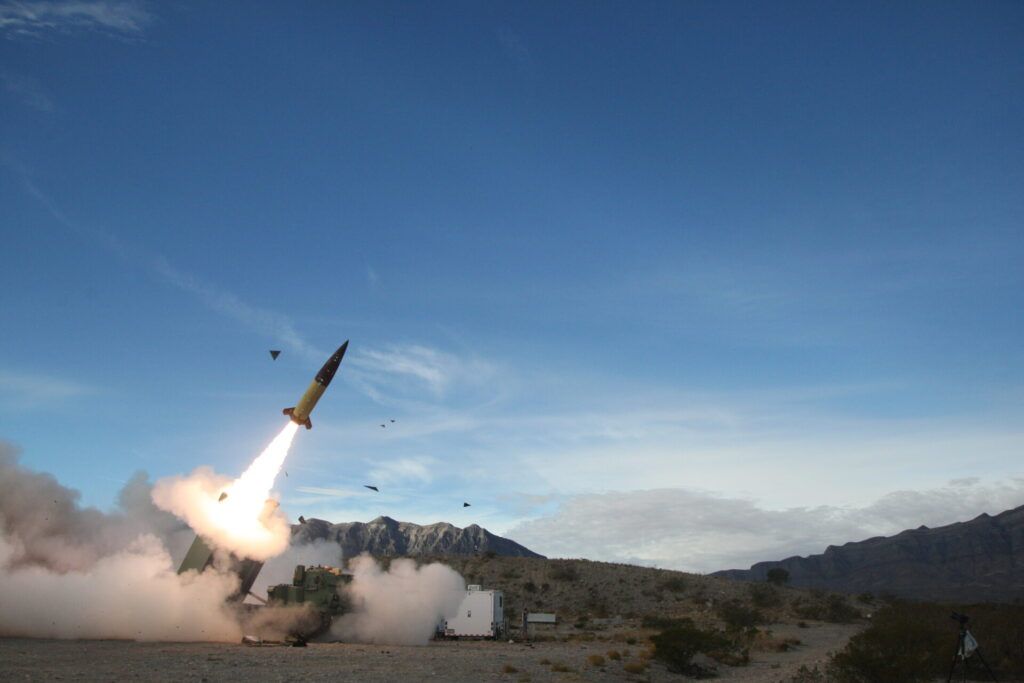Biden allowing Ukraine to strike into Russia is much ado for little consequence
By Mariana Budjeryn | November 18, 2024
 Ukraine started using the older, shorter-ranged US-supplied ballistic missiles, known as the Army Tactical Missile Systems, or ATACMS, in October 2023. The Biden administration has now allowed Ukraine to use long-range ATACMS to help defend its forces in the Kursk region of Russia. (Credit: US Government / John Hamilton, via DVIDS)
Ukraine started using the older, shorter-ranged US-supplied ballistic missiles, known as the Army Tactical Missile Systems, or ATACMS, in October 2023. The Biden administration has now allowed Ukraine to use long-range ATACMS to help defend its forces in the Kursk region of Russia. (Credit: US Government / John Hamilton, via DVIDS)
The Biden administration, after a long hesitation, finally allowed Ukraine to use US-supplied ballistic missiles, known as the Army Tactical Missile Systems, or ATACMS, on Russia’s sovereign territory. Britain and France swiftly followed by lifting restrictions on the use of their Storm Shadow/SCALP air-launched cruise missiles against targets in Russia.
Biden’s decision is perceived as a major shift in US policy. The reason for the turnaround is likely some combination of the deployment of North Korean troops on the Russian side, the mounting Russian counteroffensive in the Kursk region, and the upcoming second Trump presidency, expected to bring US military aid to Ukraine to a grinding halt.
This is not a blank check to Ukraine. The use of ATACMS still comes with restrictions—not all of which have been made public. For now, the permission to use these US weapons systems is reportedly limited to the Kursk operation, where Ukraine is already on Russian sovereign territory and has no operational depth afforded by its occupied territory to strike and thwart Russian offensive efforts. There’s just no other way to defend Ukrainian forces in the occupied swath of the Kursk region but to strike targets on Russian sovereign territory.
Ukraine must hold the Russian territory it occupies in Kursk as leverage in a future settlement—whether it’s a truce, a ceasefire, or an armistice. With Trump’s presidency on the horizon and his declared intention to end the war quickly, each belligerent is jostling to put itself in the best position possible before being summoned to the negotiation table. Hedging for Trump’s presidential win might have been a reason for Ukraine’s Kursk operation in the first place.
Russia, for its part, has not changed its war aims of destroying Ukraine as a sovereign nation—just ask German Chancellor Olaf Scholz, who spoke with Russian President Vladimir Putin last week. Russia is going to try and maneuver into a position in which negotiations, when they come, could only formalize Ukraine’s surrender. Consequently, the next two months will likely be the bloodiest in this war—for both sides.
Biden’s decision is the right one by any measure, and long overdue.
Politically, it’s a boost of morale for an embattled Ukraine facing increasingly dark times ahead and another salami slice into Russia’s impunity. Militarily, Ukrainians could certainly use these longer-range fires to hamper the Russian counter-operations in the Kursk region and possibly beyond. The ability to use ATACMS on Russian territory will save Ukrainian lives and impose greater costs on Russia.
But strategic—even operational—upsides of the ability to use these long-range fires on Russian territory are likely to be more modest than expected. Russia has already moved some high-value targets, such as aircraft, out of the range of these systems deeper into its territory. Many smaller targets, command posts, arms depots, troop concentrations, and more are still within the range of ATACMS, which is up to 300 kilometers in some modifications. The Ukrainian military could also target nodes of critical infrastructure, such as oil refineries, although it is unknown if the US decision allows the use against such targets. But stocks of ATACMSs, Storm Shadows, and SCALPs supplied to Ukraine are limited, and Kyiv will have to ration and prioritize the expenditure of these scarce and expensive munitions.
Some fear that Russia might escalate in response to the US decision. Putin has warned that Russia would regard the NATO states’ permission for Ukraine to use their weapons on Russian territory as NATO’s entry into the war. Now that the permission is granted, even if the effects of such use would be limited operationally, political reasons alone might suffice to justify a Russian escalation of the war in Ukraine.
But Russia is already in full escalatory mode in Ukraine. Since August, Russia has been pushing hard and advancing rapidly along the Donbas front. On November 17, it began another campaign against Ukraine’s critical infrastructure with a massive air strike. More such attacks will likely follow in the weeks to come aiming to plunge Ukraine into darkness and cold at the onset of winter and coerce the country into peace on Russian terms. With this new spur of escalation, reasons for which are unrelated to and precede Biden’s decision, Russia is already at the limit of its conventional escalation capacity.
It is highly doubtful that Russia may resort to “extra” escalation as a specific answer to Biden’s decision, including against a NATO target. Russia’s recent advances in Ukraine, while steady, have also been incredibly costly. The Russian military has performed poorly in this war and is stretched today—otherwise, it would not have engaged North Korean troops in the Kursk operation. For Russia to pick a fight with thirty-some NATO states at this point—or any other point, for that matter—would be highly imprudent, although not inconceivable.
Stripped of the hype, both the positive and the negative exigencies of the permission to strike targets in Russia may turn out to be rather less drastic than the preceding debates had suggested. One can’t help but wonder why US and European capitals built up the issue as so monumentally risky and controversial to begin with. Maybe it was because hype is the currency of contemporary politics. But maybe it was because Western leaders and experts have an embarrassingly poor understanding of escalation dynamics in a major conventional war in the nuclear era.
Biden’s much-agonized-about decision will not change the course of war. It is not because ATACMS are ineffectual or because Russia is invincible. Rather, it is because no single weapons system or decision has the power to change the course of a war of attrition. Only a shift in the overall balance of human, military, and economic resources might. Ukraine is inherently disadvantaged in this balance vis-à-vis Russia, which makes Ukraine’s continued survival and resistance even more incredible.
The United States and Europe have had 1000 days to tip the scales decisively in Ukraine’s favor, but they chose not to. Biden’s decision on ATACMS will help, but like much else in this war, it is too little too late.
Together, we make the world safer.
The Bulletin elevates expert voices above the noise. But as an independent nonprofit organization, our operations depend on the support of readers like you. Help us continue to deliver quality journalism that holds leaders accountable. Your support of our work at any level is important. In return, we promise our coverage will be understandable, influential, vigilant, solution-oriented, and fair-minded. Together we can make a difference.
















I disagree. Allowing Ukraine to attack strategic and operational targets outside of Ukraine, allows Ukraine more flexibility and leverage in causing more losses to Russian military resources. Ukraine has basically destroyed Russia’s offensive capability to either continue its attack in Ukraine or wage any military actions against NATO or non-NATO aligned countries in Europe. Russia has 2 options. Escalate the conflict in using nuclear weapons or targeting nuclear power plants in Ukraine, to cause as much chaos, death, and fear as possible; OR withdraw from all of Ukraine’s territory.
A lot of warmongers on this website. We are closer to nuclear war than ever before, and these hacks tell us there is nothing to see and to go about our business